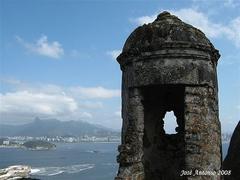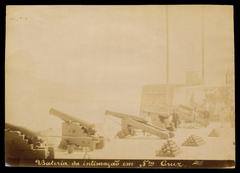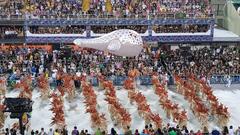Palácio Euclides Da Cunha: Visiting Hours, Tickets, and Historical Insights in Niterói, Brazil
Date: 14/06/2025
Introduction
Palácio Euclides Da Cunha is a landmark that encapsulates the political, cultural, and architectural evolution of Niterói, Brazil. Named after the acclaimed Brazilian intellectual Euclides da Cunha, this early 20th-century palace has served as a seat of power, a symbol of civic pride, and a beacon for cultural engagement. Today, it stands not only as a remarkable example of eclectic Brazilian architecture but also as a vibrant center for heritage, education, and community events. This guide provides detailed information on the palace’s history, architectural highlights, visiting hours, admission, accessibility, and nearby attractions to plan your visit.
Table of Contents
- Historical Overview
- Visitor Information
- Nearby Attractions
- Cultural and Educational Impact
- Preservation and Heritage Status
- Frequently Asked Questions (FAQ)
- Conclusion and Planning Resources
- References and Further Reading
Historical Overview
Origins and Construction
Constructed between 1913 and 1914, Palácio Euclides Da Cunha emerged during Niterói’s heyday as the capital of the state of Rio de Janeiro (MuseusBR, Prefeitura de Niterói). Dedicated to Euclides da Cunha—engineer, writer, and author of Os Sertões—the palace signified the city’s ambition to cement itself as an administrative and cultural hub. As the home of the Legislative Assembly, it played a central role in state governance until 1975, when the capital transferred to the city of Rio de Janeiro.
Architectural Significance
Palácio Euclides Da Cunha is a masterpiece of Brazilian eclecticism, blending neoclassical, Renaissance, and Baroque motifs with local materials and craftsmanship (Enciclopédia Itaú Cultural). The symmetrical façade is adorned with Corinthian columns, ornate pediments, and classical cornices. The grand portico and central clock tower, topped by a domed cupola with imported European mechanisms, exemplify its monumental presence (Niterói em Foco). Inside, marble staircases, stained-glass skylights, and hand-painted murals evoke themes of justice, progress, and Brazilian history (Niterói Turismo, Museus do Brasil).
Restoration efforts have preserved original features while integrating modern amenities, including accessibility upgrades, climate control, and digital resources (Câmara Municipal de Niterói). The surrounding gardens, with their Portuguese mosaic pathways and manicured greenery, offer a tranquil escape in the heart of the city (Revista AU).
Role in Local History
As the legislative epicenter, the palace hosted critical debates and policy-making that shaped the state’s trajectory, including during the pivotal merger of the states of Guanabara and Rio de Janeiro (ALERJ). Throughout the military dictatorship (1964–1985), it also served as a stage for civic demonstrations and the pursuit of democratic rights. Even after the capital’s relocation, Palácio Euclides Da Cunha retained its standing as a focal point for cultural and civic life, hosting exhibitions, lectures, and forums (Niterói History).
Visitor Information
Visiting Hours and Admission
- Open: Tuesday to Sunday, 9:00 AM – 5:00 PM (with last entry at 4:30 PM)
- Closed: Mondays and public holidays
- Admission: Free; some special events or exhibitions may require tickets, available on-site or by advance booking
For the most current information, check the Câmara Municipal de Niterói website.
Guided Tours and Accessibility
- Guided Tours: Available on weekends and by appointment; advance booking recommended for groups and schools. Tours provide in-depth context on architecture, history, and the legacy of Euclides da Cunha.
- Accessibility: The palace is fully wheelchair accessible, with ramps, elevators, and accessible restrooms. Multilingual signage and assistance for visitors with special needs are available (ALERJ Accessibility).
Visitor Tips
- Arrive early to avoid crowds, especially on weekends.
- Photography is allowed in most areas, but flash may be restricted in rooms with delicate artwork.
- Wear comfortable shoes for walking spacious halls and gardens.
- Take advantage of nearby attractions to enrich your visit.
Nearby Attractions
Enhance your experience in Niterói’s historic center by visiting:
- Niterói Contemporary Art Museum (MAC): Oscar Niemeyer’s architectural icon with panoramic bay views.
- Fortaleza de Santa Cruz da Barra: A historic coastal fort offering guided tours.
- Historic Churches: Explore colonial-era churches and public squares for local culture and history.
For additional local travel tips, visit the Niterói Travel Guide.
Cultural and Educational Impact
Palácio Euclides Da Cunha is not just a monument but a living institution, fostering dialogue on Brazilian democracy, literature, and civic engagement. The palace regularly hosts thematic exhibitions, lectures, and annual events such as the Euclides da Cunha Week—celebrating the writer’s legacy with performances and workshops (Niterói Cultural Agenda). Educational programs attract students, residents, and tourists, making history accessible and relevant.
Preservation and Heritage Status
Recognized as a protected heritage site by the Instituto Estadual do Patrimônio Cultural (INEPAC), the palace has undergone comprehensive restoration to safeguard its structure, artworks, and decorative elements (INEPAC). These efforts ensure the building remains a vital, accessible part of Niterói’s architectural legacy, supporting sustainable tourism and community engagement.
Frequently Asked Questions (FAQ)
Q: What are Palácio Euclides Da Cunha’s visiting hours?
A: Tuesday to Sunday, 9:00 AM to 5:00 PM; closed Mondays and public holidays.
Q: Is there an entrance fee?
A: Admission is free. Certain special events may require a ticket.
Q: Are guided tours available?
A: Yes, on weekends or by advance booking.
Q: Is the palace accessible for visitors with disabilities?
A: Yes, the palace offers ramps, elevators, and accessible restrooms.
Q: Can I take photographs inside?
A: Photography is allowed in most areas; flash or tripods may be restricted.
Q: How do I get there?
A: Located at Rua Dr. Celestino, 19, Centro, Niterói, the palace is easily reached by public transport or car. Ample parking is nearby and it is a short walk from the bus terminal.
Conclusion and Planning Resources
Palácio Euclides Da Cunha stands as a testament to Niterói’s resilience, civic pride, and architectural grandeur. Its historical significance, accessible location, and vibrant cultural programming make it a must-visit for anyone interested in Brazilian history, architecture, or community life. To maximize your visit, consult the Câmara Municipal de Niterói and Niterói Travel Guide for the latest updates on events, guided tours, and accessibility.
Enhance your experience by downloading the Audiala app for real-time updates, interactive content, and digital tours. Follow Niterói’s cultural institutions on social media for event news and heritage programming.
References and Further Reading
- Wikidata
- Niterói History
- Câmara Municipal de Niterói
- Enciclopédia Itaú Cultural
- Niterói Turismo
- Museus do Brasil
- Niterói em Foco
- Revista AU
- MuseusBR
- ALERJ
- INEPAC
- Visit Niterói
- Niterói Cultural Agenda
- ALERJ Accessibility



